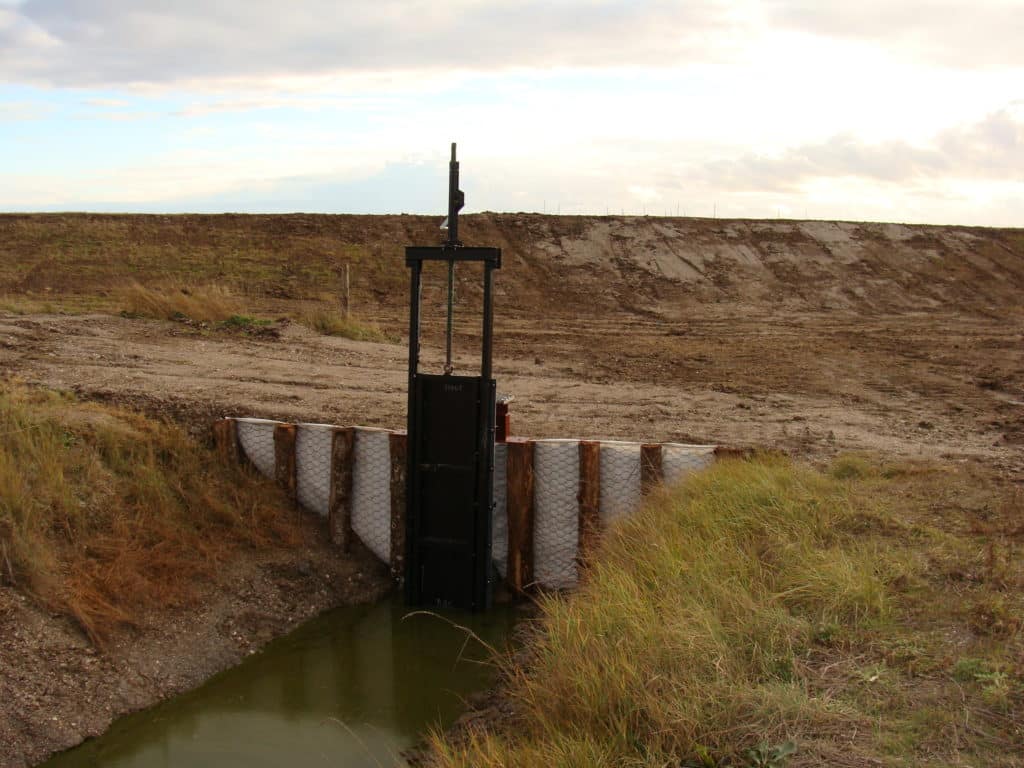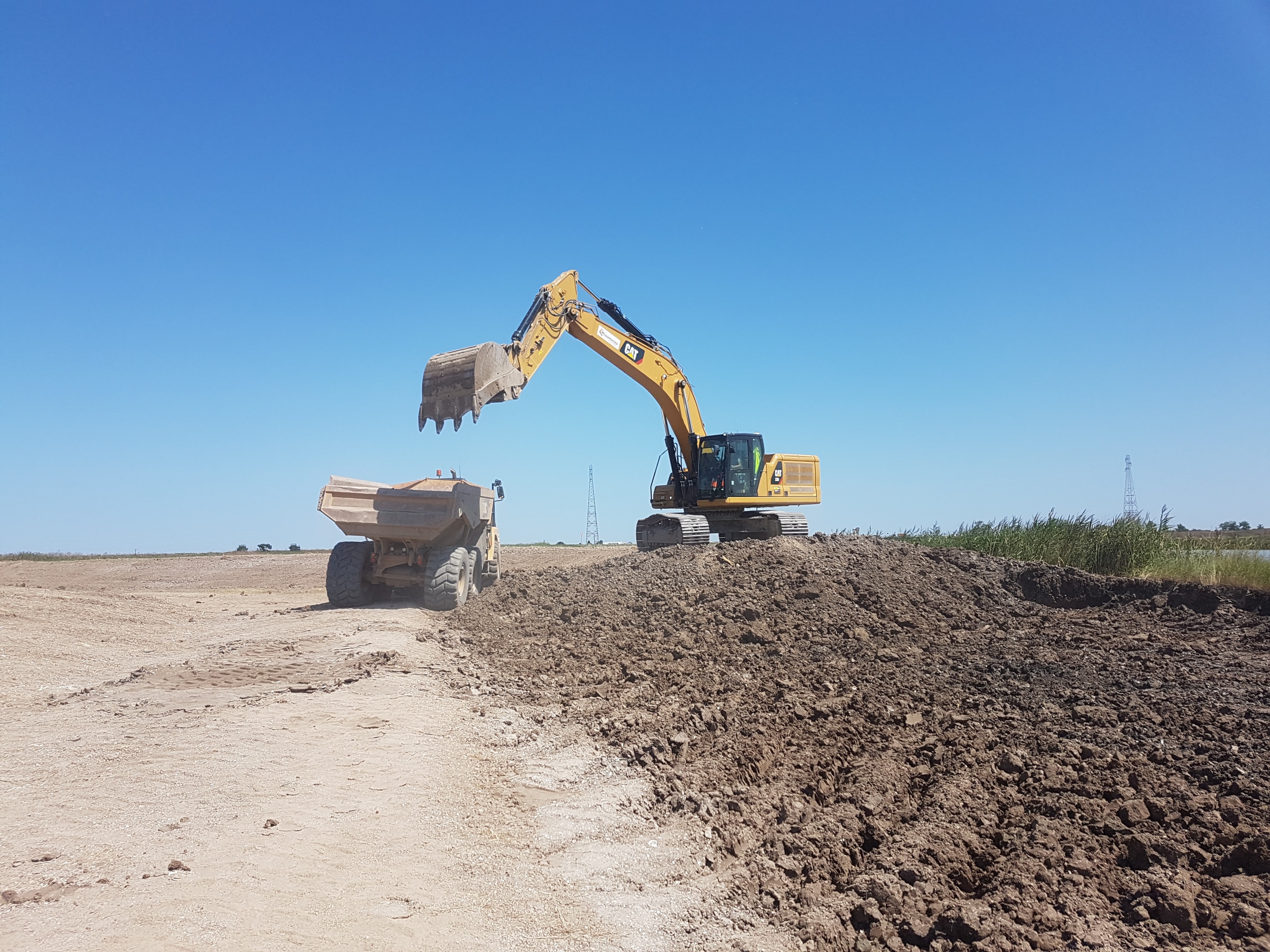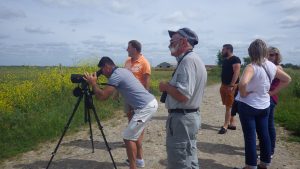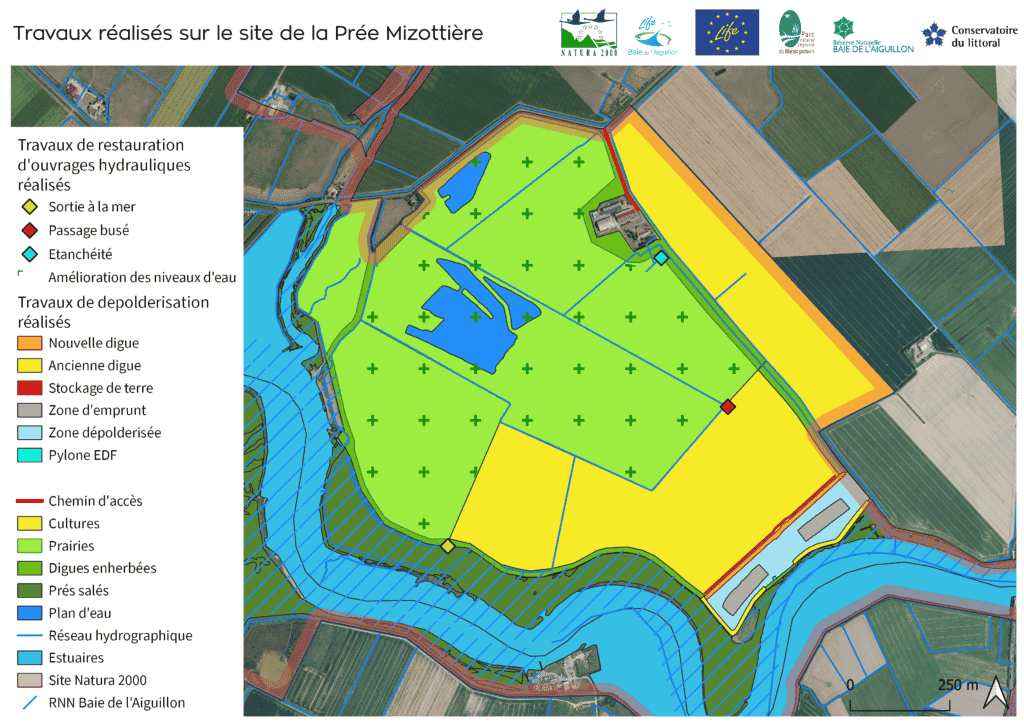Prée Mizottière
The Prée Mizottière operational action
The Prée Mizottière is owned by the “Conservatoire du Littoral” since 2004. An innovative experiment has been conducted on this former grain polder. Since then, a farmer has used the land for mixed-farming and livestock rearing. This classic arrangement should be accompanied by strong environmental ambitions, which requires both detailed site management (both agricultural and hydraulic) and ongoing dialogue between farmers and environmentalists. Adaptation and pragmatism are the key words.
An agro-environmental initiative
of the Conservatoire du littoral
An ecological corridor between the marsh and the bay
especially for migratory species whose numbers are constantly rising
Evolving habitats
that favour slightly brackish grasslands of high ecological value
PREE MIZOTTIÈRE, RECONCILING AGRICULTURE AND THE ENVIRONMENT
The Prée Mizottière farm is owned by the Conservatoire du Littoral, acquired in 2004. The initial objective of this acquisition was to establish livestock rearing, on polder used for growing cereals, compatible with the creation of an important ecological zone.
The consequences of storm Xynthia have contributed to the rethinking of this project. In fact, dykes had to be repaired from the materials on site creating a vast wetland that evolved partly towards hygrophilous meadows and partly the creation of ponds. This site is now used by a large population of nesting and overwintering birds. The ornithological interest of the site is now recognised by local decision makers and ornithologists.

Sheep at Prée Mizottière © the Aiguillon Bay National Nature Reserve
ECOLOGICAL RESTORATION WORK
The LIFE project allows further progress within this philosophy by incorporating:
- Restoration of an outlet to the sea in order to be able to evacuate water by gravity (which leads to the lack of need of drainage pumps).
- The installation of a hydraulic management structure in order to be able to guarantee a minimum flooding of certain sectors of land.
- The removal of a portion of the sea dyke in order to create a real estuarine environment (saltmarsh, reedbeds) in the place of cereal growing.
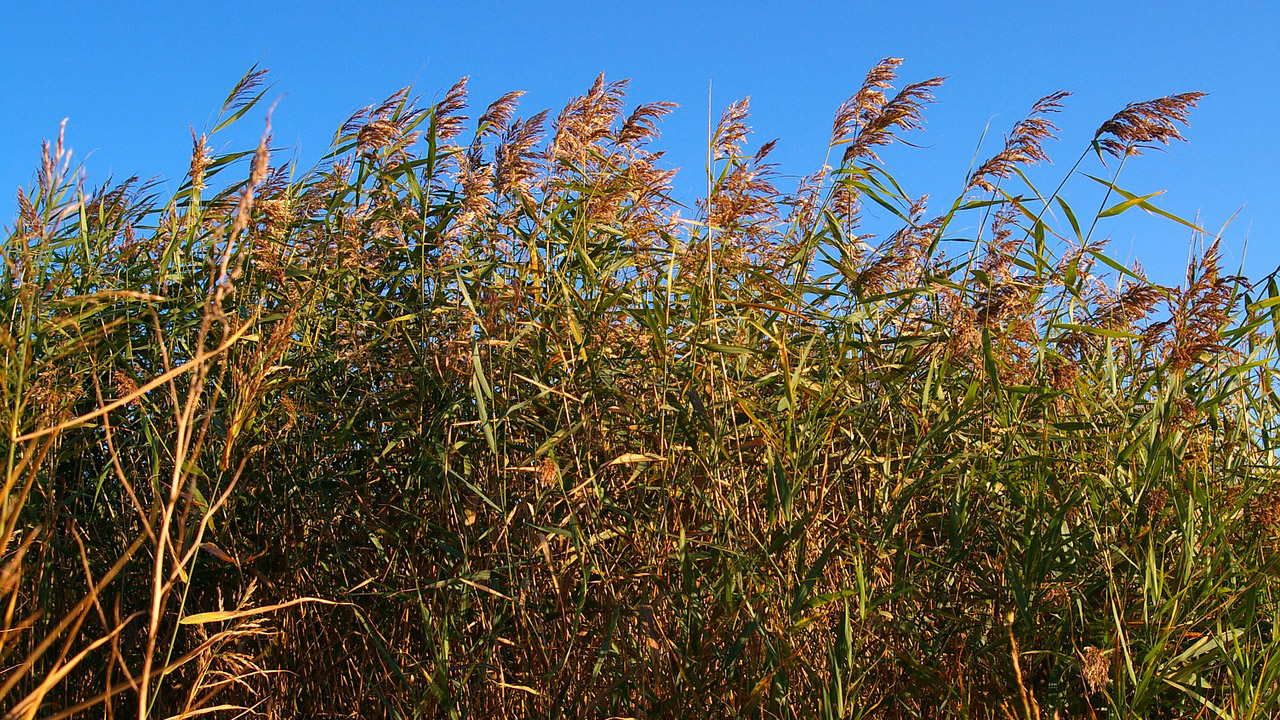
A reedbed
EDUCATIONAL ENHANCEMENT WORK
The Prée Mizottière site is intended to demonstrate the compatibility of strong ecological ambition and realistic economic exploitation. Added to this is its educational value. It is important that the site is accessible to the public to observe the open landscape of grazed grasslands and depressions favoured by migratory birds. This site participates in a reflection on the development of eco-tourism in the Marais Poitevin.
- Creation of an observation platform,
- Marking the acces path
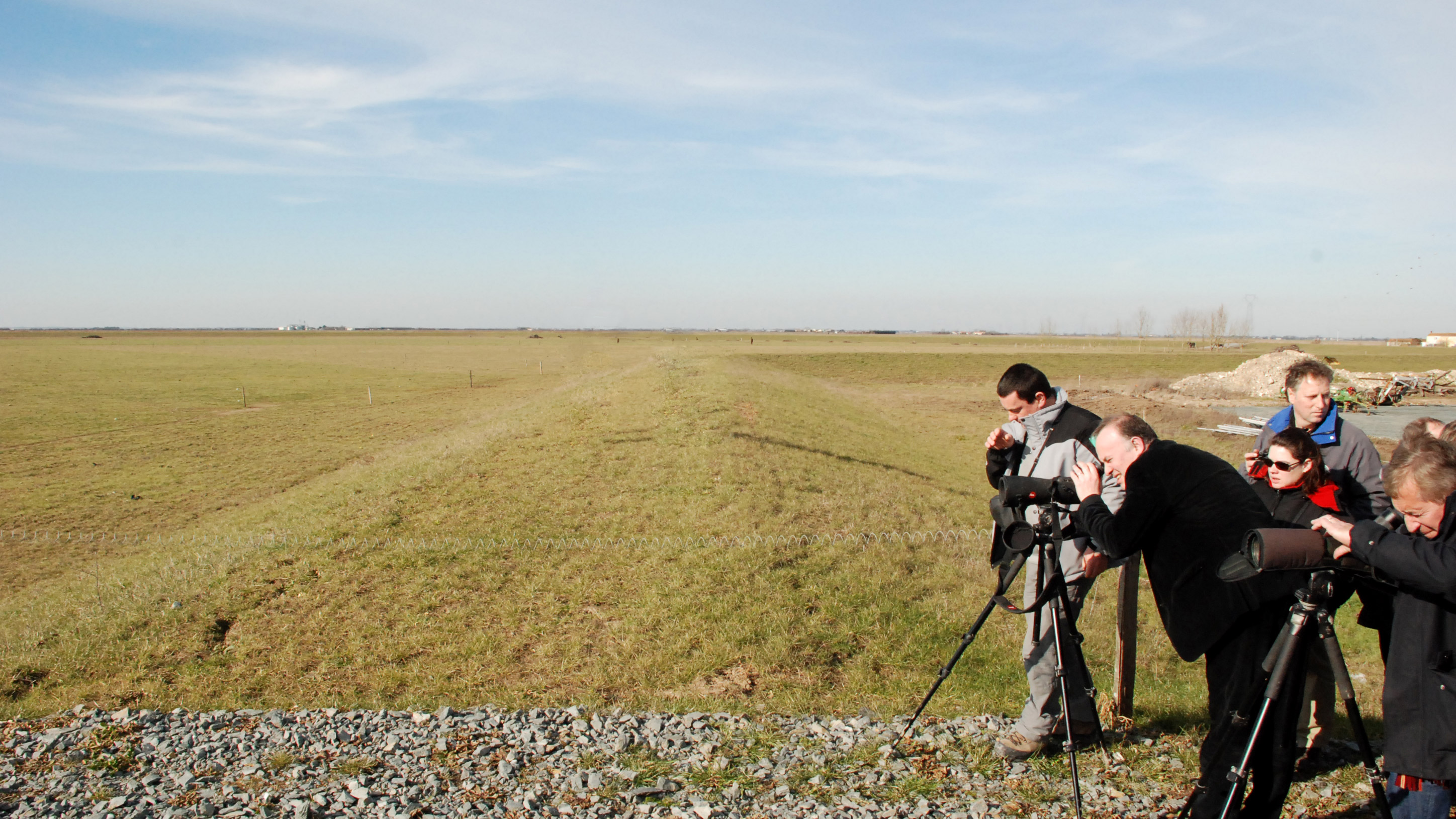
Observing birds near the Prée Mizottière farm
BIOLOGICAL MONITORING OF PRÉE MIZOTTIÈRE
The work envisaged is concerned with the restoration of natural environments. It is therefore essential to monitor those species that occur on the natural meadows and wetlands of Prée Mizottière before and after work.
Habitat mapping was carried out in 2019 and 2021 to monitor the evolution of vegetation.
A monitoring of the nesting avifauna (passerines and waders) as well as a monitoring of amphibian species was carried out in the springs of 2017, 2018, 2019, 2020 and 2021.
Avifauna
The number of species and numbers of waterbirds counted monthly have been higher on the site since 2019. The number of nesting passerines contacted has increased since 2017, but it is still too early to observe a trend in the depoldered area. The monitoring of breeding birds is to be continued in the years to come in order to assess the relevance of the work on the attractiveness of the site.
Amphibians
Four species of amphibians have been identified on the site: The Green Frog sp (Pelophylax sp), the Southern Tree Frog (Hyla meridionalis), the Thorny Toad (Bufo spinosus) and the Spotted Pelodyte (Pelodytes punctatus). The monitoring carried out reveals an increase in the number of amphibians heard in the area since 2017 as well as an increase in the number of meshes occupied since 2018 despite a slight decrease for the two indicators between 2020 and 2021. The listening point protocol induces several factors influencing detectability and making analysis difficult. A follow-up over 5 years is insufficient to conclude on the evolution of the occupation of amphibians and in particular to make the link with the improvement of hydraulic management by the work of the LIFE project.
ACTIONS ALREADY FINISHED
The following hydraulic management work has been carried out: the creation of a sea outlet (to allow the natural evacuation of rainwater by gravity so that the agricultural drainage pumps of the plots are redundant), reopening of a non-functional piped passage (to allow better flooding of a natural zone of more than 20 hectares), restoration of a defective hydraulic structure (to allow better management of water levels on the site). The work was carried out during November and December 2017.
These facilities are currently in operation, managed by the Reserve managers. This work allows the management of about twenty hectares of grasslands.
Work to move the main dyke at Prée Mizottière inland, owned by the Coastal Conservatory, is part of an agro-environmental project. This work incurs the loss of cultivated areas in favour of the restoration of natural habitats targeted by the project. The aim is to create some 10 hectares of saltmarsh. Preliminary studies have been completed and work has been underway since mid-July 2020.
The dyke was moved during the summer of 2020. The works began in mid-July 2020 and ended in September 2020. More information here and here.
Various monitoring takes place in the new area to follow its evolution: topographic monitoring, waterbird counts, monitoring of benthic macrofauna and vegetation.
EDUCATIONAL USE OF PRÉE MIZOTTIÈRE
The valorisation of educational work has not yet been initiated. Nevertheless, activities are carried out regularly on the Prée Mizottière site by the farmer and staff of the nature reserve for the general public or students.




